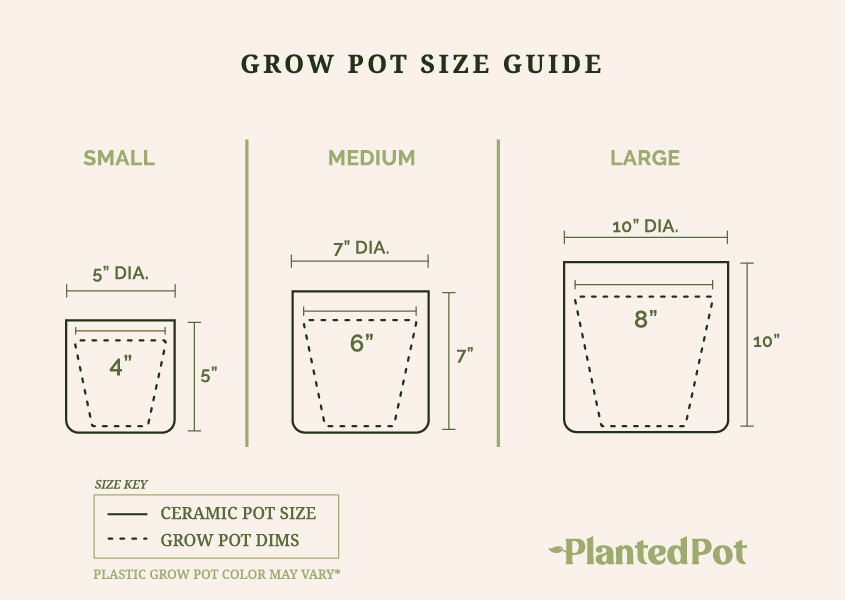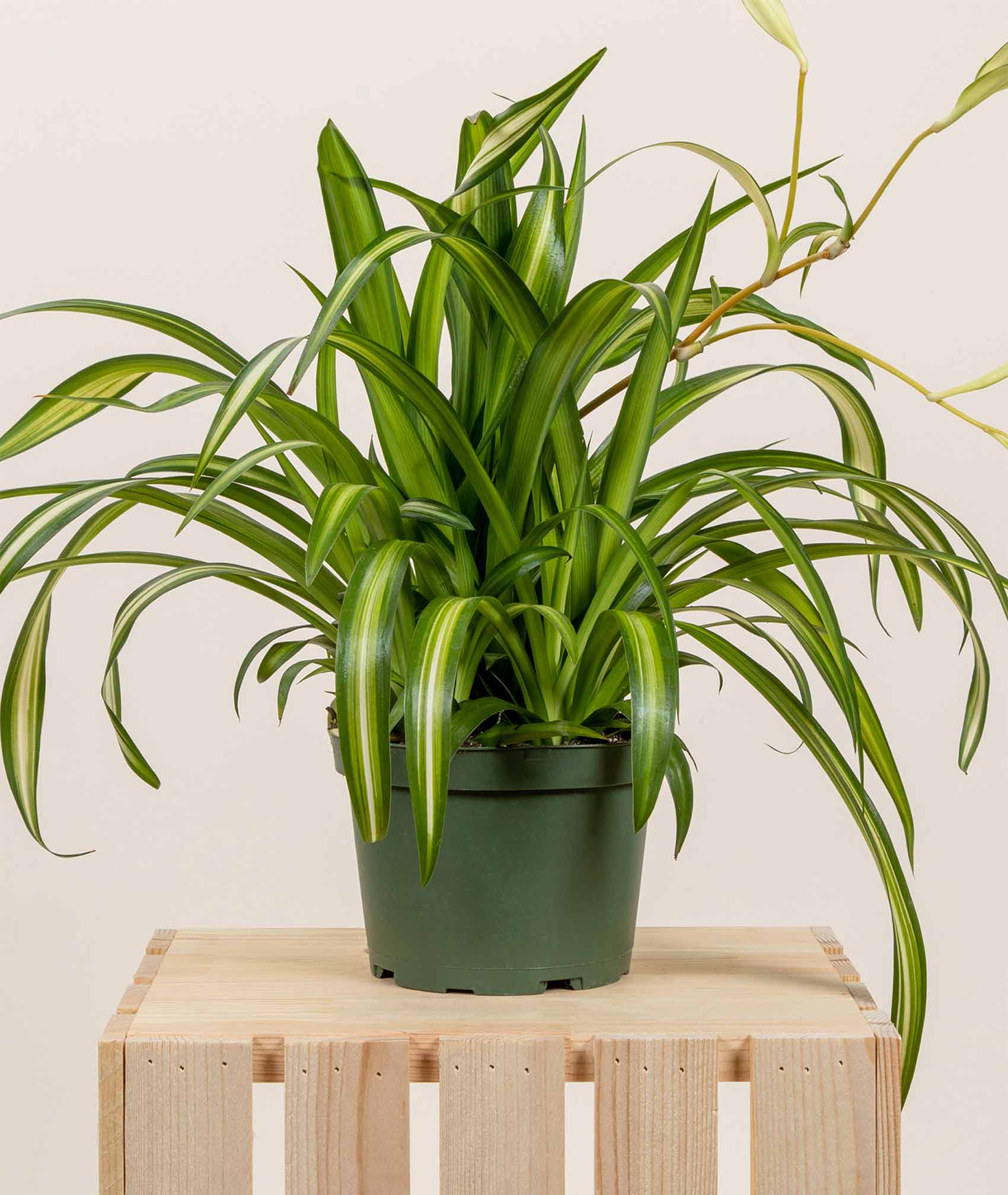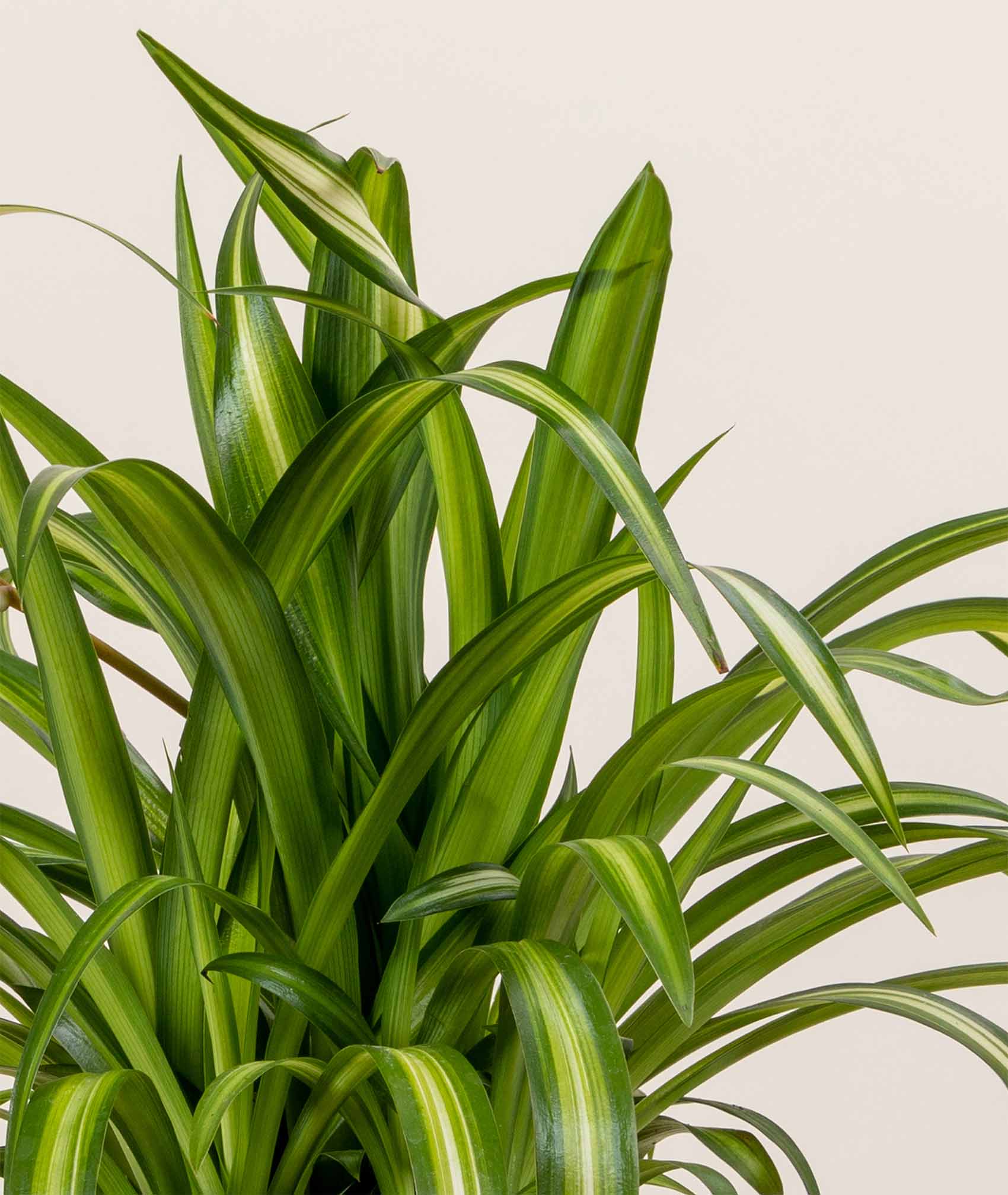
Hawaiian Spider Plant
$32
 Plastic grow pots come in different colors, you may receive a black or rust colored pot.
Plastic grow pots come in different colors, you may receive a black or rust colored pot.
If you love Spider Plants but wish their leaves were just a bit wider and greener, the Hawaiian variety offers just that. The Spider Plant Hawaiian’s leaves are broader and greener than the average Snake Plant, with a stunning, light-colored stripe running down their center. This makes the plant variegated, or striped. One of our favorite things about house plants is the variety, and the Hawaiian proves that even among Spider Plants, there is an incredible range of selection. The Hawaiian is just as easy to care for as other Spider Plants, and it can grow to an impressive yet manageable two feet in height.
Spider plants can survive in light ranging from semi-shade to partial direct sunlight, but do their best when they receive bright, indirect sunlight. The only type of light you want to avoid with your spider plant is hot, direct sunlight, which will scorch the plant’s leaves, causing the tips to turn brown.
Throughout the summer, you should water regularly and keep soil evenly moist. During the winter months, the soil should be allowed to dry out briefly between waterings.
70°F – 80°F
Related Products
Hawaiian Spider Plant
The Hawaiian Spider Plant is a bold and unique Chlorophytum plant with its intricate golden stripes down the leaves and popping green foliage. As a native to the tropical weather of southern Africa, the Spider Plant enjoys basking in the warm weather and sprawling out its long leaves like a bunch of spider legs.
Often referred to as the Ribbon or Airplane Plant, the Hawaiian Spider Plant is an easy to care for species that promises to add plenty of life to your indoor or outdoor garden. Let’s take a closer look at this particular plant, how to care for Spider Plants in general, why you should add a Hawaiian Spider Plant to your home, and some similar species!
What is a Hawaiian Spider Plant?
The Hawaiian Spider Plant — also known by its scientific name Chlorophytum comosum — is an exotic plant originating from the southern Africa tropics. This wonderful creature has migrated worldwide, becoming one of the most popular plants to care for.
Although there are several versions of the Spider Plant, the Hawaiian species is known for its bright-green leaves with a golden stripe down the middle. The leaves are lengthy and sprawl out on all sides, similar to the legs of a spider, adding to the chaotic beauty of the plant.
Despite being a native to the warm weather of southern Africa, the Spider is a rather adaptable house plant that is fairly easy to grow. The Spider Plant is versatile and can be great for either indoor or outdoor environments. This is a perfect plant to hang from a ceiling or by a window, or on a kitchen table with its long leaves. The possibilities are endless for this Spider. Under the right conditions, Spider plants are known to live up to 20 years!

Size
The Spider is a smaller-sized plant that can grow up to 2 feet tall and wide. The leaves may appear as if they need tons of space to stretch out, but rest assured this plant typically stays within 2 feet out of its natural habitat.
Lighting
The Hawaiian Spider generally enjoys indirect lighting as direct sunlight will scorch its leaves. Finding a semi-shady spot with plenty of warmth should be perfect for your Spider. When you find the sweet spot, you will notice your Spider’s leaves becoming more prominent and the middle stripe glowing brighter than ever.
Water
The best bet for your Spider Plant is to water it when the top half of the soil is dry. Make sure the water flows all the way through the drainage holes at the bottom of the pot to avoid any still water. Too much watering can lead to root rotting, and the plant may become soggy. Spider Plants are sensitive to fluoride found in tap water, so for the best results use distilled or rainwater.
Temperature
The Hawaiian Spider Plant prefers weather conditions similar to its home: hot and humid. Spider Plants do best in temperatures ranging from 70° to 80° Fahrenheit. If you decide to grow your plant outside, make sure to bring it inside if the temperature dips below 50° Fahrenheit at night.
Spider Plants can tough it through most living conditions, even dry ones. In fact, they enjoy humid environments the most! Regularly misting your Hawaiian Spider will keep them happy and thriving.
Feeding
The Chlorophytum comosum only needs to be fed once a month during the spring and summertime. For the best growing results, use a liquid-based fertilizer with no fluoride and very little boron.
Why Choose a Hawaiian Spider Plant for Your Home?
Aside from its exotic beauty and lively charm, the Chlorophytum comosum plant is perfect for your home for a handful of reasons. Here are some of the potential benefits of choosing a Hawaiian Spider for your home.
Purifies the Air
One of the best benefits of having a Spider Plant is that it can clean the air inside our homes. Of course, all plants convert carbon dioxide into oxygen. Additionally, the Spider Plant can remove harmful air pollutants like carbon monoxide, formaldehyde, and xylene. So, not only are you adding a bit of natural beauty into your home, but your plant is also helping you breathe easier.
Relieves Stress
Another perk of having indoor plants is that they are known to help reduce stress. A study done by the Journal of Physiological Anthropology found that participants who were in the presence of plants had reduced physiological and psychological stress levels. Whether you had a long day at work or need to calm your mood a bit, a house plant can help with that!
Difficult to Kill
For the most part, Spider Plants can thrive in almost any type of environment. Although they prefer warmth, Spiders can survive various climatic conditions even when over or under-watered. This plant can go through a few days of neglect and show little to no signs of wilting.
Safe for Pets
One final benefit for any Spider Plant owner is that they are non-toxic to pets. Sometimes other plants can cause your stress levels to increase because your furry friend might ingest some leaves when you are not looking. However, the Spider Plants do not have any toxic properties and will not make your pet sick if they munch on a couple of leaves.

Are Hawaiian Spider Plants Good Indoors & Outdoors?
Under the right conditions, Hawaiian Spider Plants can be great indoor and outdoor plants. If you plan to keep this plant inside, provide a space where they have plenty of indirect light available to them. Putting them in an area where they receive direct lighting can be overwhelming and scorch their leaves.
Although this plant is on the smaller side, its leaves can get rather long and out of control. So provide a spot inside your home where you can hang your Spider Plant so its leaves can be free is a good idea.
If you want to keep your Spider Plant outside, they will love taking in all the heat. Spiders are accustomed to warm weather and thrive outside. As long as you find a nice, shady spot where they can be warm but not get too much direct sunlight, your Spider will do great outside.
Are Hawaiian Spider Plants Pet and Children Friendly?
It can be a headache bringing home a plant and finding out that it is toxic to pets and younger children. However, according to the American Society for the Prevention of Cruelty of Animals (ASPCA), the Spider Plant is non-toxic.
It is still recommended to keep any plants away from your pets and children because they can cause damage to the plant or make a mess around the house, but you can rest easy knowing that the Spider will not make any of your loved ones sick.
Hawaiian Spider Plant Family Relatives
The Hawaiian is just one variation of Chlorophytum comosum (Spider Plant), a species of perennial flowering plants. A perennial plant is a plant that lives longer than two years. The Chlorophytum comosum plant is native to the tropical areas of southern Africa and has become a staple in the world of plant collecting.
These plants have long, narrow, hanging leaves with inflorescence flowers. They have become popular as house plants due to their green foliage and their lively physical characteristics. There are two common variegated cultivars that the house plants fall under: Vittatum and Variegatum.
Chlorophytum comosum “Vittatum” plants are a mild green with a broad central white stripe, like the Hawaiian. These plants are usually hanging to let the leaves naturally fall over the sides of the pot. In contrast, the “Variegatum” plant has darker green leaves with white margins. These plants are typically smaller than the Vittatum variant.
Plants That Are Similar to the Hawaiian Spider Plant
There is quite an assortment of Spider Plant species available besides the Hawaiian, and other plant types that are similar in physicality, color, and size. Here are a few plants that you may be interested in:
- Bonnie Spider Plant
- Variegated Spider Plant
- Snake Plant
- Tillandsia
- Dracaena
- Zebra Plant
Final Thoughts – Hawaiian Spider Plant
Despite not being from Hawaii, the Hawaiian Spider Plant is an exquisite plant species that brings its easy-living vibes and chilled-out aesthetic to any home. If you are interested in having your very own Spider Plant, take a look at our great selection of house plants!





Reviews
There are no reviews yet.